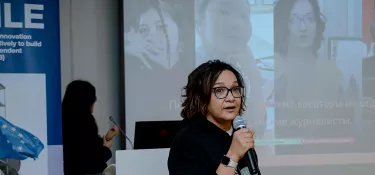
A better understanding of the media in Iraq, Libya and Yemen
Related project
ILYM (Iraq - Libya - Yemen Media)To mark the launch of ILYM (Iraq Libya Yemen Media) at the offices of AFP on 9 November 2015, CFI looks at the current situation of the media in Iraq, Libya and Yemen.

Iraq
There are hundreds of publications and scores of radio and television stations in Iraq. Against a background of political crisis and instability, the media scene is increasingly fragmented. Television is the chief means of information, with 92% of adults citing television as their primary source of information.
Many media have political or religious affiliations. The autonomous region of Kurdistan has its own established media. For private media, however, advertising revenue seldom offers a reliable and sustainable source of income.
Although freedom of expression is protected by the constitution, Reporters Without Borders emphasises just how much journalists are systematically persecuted by Islamic State terrorists.
As for the Internet, Iraq has the lowest level of penetration in the region with 2.7 million users in 2014, about 8% of the population. In June 2014, the authorities suspended Internet services for a time in some predominantly Sunni areas, citing security reasons.

Libya
The overthrow of Colonel Gaddafi in 2011 ended a 42-year dictatorship during which the media sector was under almost total state control, and no independent or critical voices were tolerated. Since then, there has been a proliferation of satellite TV channels and dozens of radio stations, all private, broadcasting from various Libyan cities, as well as from other Arab countries.
The media landscape has changed dramatically. Former state newspapers have closed and new titles have appeared, with no real sustainable prospects. Benghazi has emerged as a publishing hub. However, there are few daily newspapers and print runs are very limited.
Facebook, Twitter and YouTube played a crucial role in the flow of information during the revolt. In December 2013, out of a population of 6.4 million, there were nearly one million Internet users. Facebook has become the preferred platform for Libyans wishing to read the news and comment on events.
The media sector is still not regulated despite the establishment of a new information ministry in September 2013. With the government in crisis, there has been little progress in terms of media legislation. Since 2014, the chaotic state of the media has reflected Libya's political instability.

Yemen
The Yemen Radio and Television Corporation( YRTC) and the news agency no longer have a monopoly on information. The audiovisual sector has seen the emergence of a multitude of private satellite radio and television channels with strong political affiliations.
In 2014, as political uncertainty and insecurity took hold, Reporters Without Borders recorded a considerable number of threats and attacks by the security forces and other unidentified groups against journalists. The Shiite Houthi movement also joined the ranks of the enemies of press freedom. The rebels particularly targeted the offices of the national broadcaster.
In 2014, there were only 4.8 million Internet users in Yemen, the lowest penetration rate in the region after Iraq. Yemen has 1.5 million Facebook users and 128,000 Twitter users.


